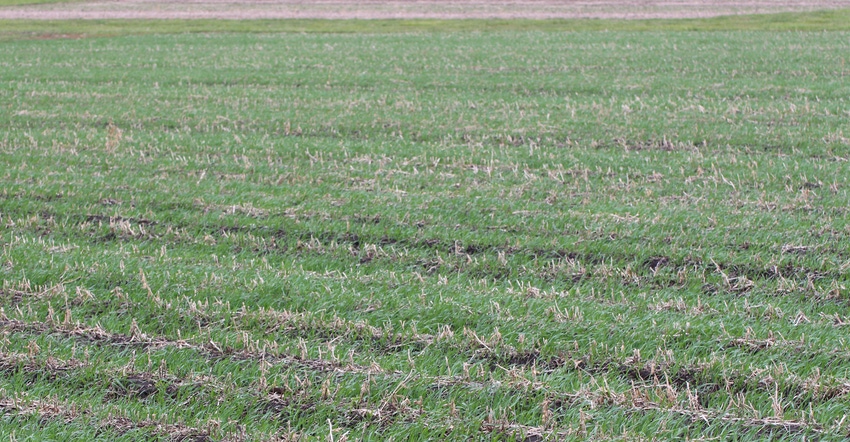January 25, 2019

A new Iowa State University study shows how active farmer involvement in watershed management groups and other conservation networks is key to getting wider adoption of conservation practices like cover crops.
The study, published recently in the journal Water Resources Research, is based on survey research conducted in three watersheds connected to rivers in Iowa: the Iowa River watershed, Missouri-Little Sioux and Upper Mississippi-Maquoketa. It sheds light on factors related to adoption of cover crops and other conservation practices.
A team of ISU researchers in sociology and statistics analyzed data from the first two years (2015-16) of a five-year survey measuring Iowa farmers’ awareness, attitudes and actions in support of the Iowa Nutrient Reduction Strategy’s water quality improvement objectives.
The Iowa Nutrient Reduction Strategy is a statewide effort that began in 2013 to encourage voluntary adoption of conservation practices by farmers to reduce the loss of nitrogen and phosphorus that contribute to water quality impairments in the Upper Mississippi watershed and drive hypoxic conditions in the Gulf of Mexico.
Why do farmers adopt cover crops?
“Our first analyses focused on adoption of cover crops because it’s one of the most effective practices for reducing nutrient and soil loss, and has been heavily promoted,” says Laurie Nowatzke, Nutrient Reduction Strategy measurement coordinator at ISU and co-author of the study. “So it’s important for us to better understand the factors that influence adoption of the practice here in Iowa.”
A primary focus of the study was how awareness of and attitudes toward the Nutrient Reduction Strategy and its goals might influence adoption.
“ISU Extension and stakeholder partners have put a lot of effort into raising awareness of the Nutrient Reduction Strategy, cultivating positive attitudes toward its objectives and promoting conservation practices, both with farmers and their advisers such as ag retailers,” says J. Arbuckle, associate professor and ISU Extension sociologist, who co-authored the study. “Our analysis examined how awareness and attitudes might mediate other variables, such as cost share or the influence of information sources, such as Extension specialists.”
The researchers measured the direct effect of key factors influencing cover crops adoption, such as information sources, nutrient management approaches, involvement in watershed management activities and conservation technical assistance. They also analyzed the indirect effects of those same variables as mediated through awareness and attitudes.
Twice as likely to use cover crops
Results showed participation in organized watershed management and receipt of cost-share funds or technical assistance had large positive direct effects on cover crop use. Farmers who participated in watershed group activities were almost 40% more likely to be using cover crops. Those who had received cost-share funds or other conservation assistance in the previous five years were twice as likely to report cover crop use.
"Farmers who get involved in watershed management activities and conservation networks are much more likely to use cover crops,” notes Nowatzke. “The results of this study align with previous research conducted in Iowa and other Midwest states. This adds to the mounting evidence that watershed-based conservation approaches are effective.”
Results of this latest study also indicate that information sources such as conservation organizations, the farm press and ag retailers may have important indirect effects by shaping farmer awareness and attitudes. Farmers who said they learned about the Nutrient Reduction Strategy through public entities such as the Iowa Department of Ag and Land Stewardship and through the farm press were about 5% more likely to be using cover crops.
Influence farmers’ awareness
Similarly, farmers who indicated that nongovernmental organizations like Practical Farmers of Iowa and public sector groups (such as IDALS) influence their nutrient management decisions were 3% and 6% more likely to report using cover crops, respectively. Farmers who rated private-sector entities such as ag retailers as more influential were about 4% less likely to report using cover crops.
“Agricultural stakeholders’ influence on farmers’ awareness and attitudes can impact conservation practice adoption,” Arbuckle says. “It’s important for all stakeholders to focus on positive messaging and actions that increase farmers’ willingness and capacity to adopt.”
Getting farmers involved
The main takeaway from this initial analysis of the Nutrient Reduction Strategy survey data is that getting farmers engaged in watershed management groups and other conservation networks is key. “Recruiting farmers into such programs and networks takes time, money and other resources,” Nowatzke says. “But our work strengthens research-based evidence pointing to its effectiveness in getting conservation practices implemented.”
The research was funded by ISU Extension, IDALS, Iowa State’s College of Agriculture and Life Sciences, and Iowa State’s Agriculture Experiment Station.
Source: Iowa State University, which is solely responsible for the information provided and is wholly owned by the source. Informa Business Media and all its subsidiaries are not responsible for any of the content contained in this information asset.
You May Also Like




